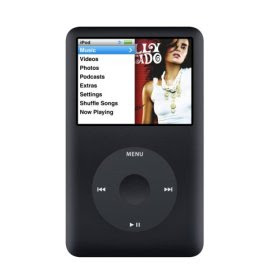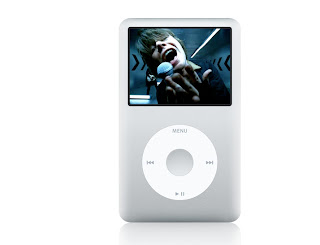New Apple iPod Video

Apple's trend to more compact packaging continues. The original new apple iPod video shipped in a 6" cube box; you removed the box from its sleeve, then unfolded it like a flower. Our 60 GB iPod Video arrived in an attractive flat, square box, matte black with embossed silver Apple logo and text - which we found remarkably difficult to get into. This presaged a tricky box-opening experience in which style utterly defeated substance.
We eventually figured out that the visible box was a sleeve with one end open (like a DVD box set), and with much shaking and pulling, managed to extract the inner box. The stylish matte black and precise fit make it hard to extract. The inner box opens in half - one side containing the iPod, and the other a solid black monolith - but where were the cables?
The new apple iPod video lacks a printed manual, but an electronic manual is included on the CD. We discovered that what looks and acts like a PDF file is actually a Mac OS X application that detects your language and displays the appropriate PDF, so long as your language is English, French, German, Japanese or Chinese. We do wonder why Spanish wasn't included.
The top edge of the box is marked with small, unobtrusive symbols for CD, USB and headphones, tipping us off that it was a box flap. We opened it and extracted a white plastic envelope containing a CD, a tiny "Quick Start Guide" and copious copyright statements, a pale grey protective sleeve for iPod, and what for all the world looked like an Apple-white package of instant oatmeal.
The oatmeal package, divided into two halves, contained a USB adapter cable and iPod's iconic earbuds. Too tough to rip open, we fetched a sharp knife and carefully made a slit. Care is strongly advised, even with scissors - the earbuds are a tight fit, and it would be all too easy to damage their thin cables while trying to get in. The USB cable is only slightly more robust.
The good of new Apple iPod Video: Incredibly thin and intuitive design; beautiful LCD; supports photo and video playback; seamless integration with iTunes, which boasts the world's biggest music catalog and a new video store; smooth video; lots of extra features, such as a world clock, a stopwatch, and PIM applications; a galaxy of accessories designed for the iPod; great overall value.
The bad of new Apple iPod Video: No extras included, such as a dock, A/V cables, or a power adapter; poor battery life for video; slight delay when playing video; no guarantee that your non-iTunes Music Store video will play on an iPod, even after using converted third-party software.
The bottom line: Get the affordable, sleek, and sexy 5G Apple iPod for its audio virtues. Although video looks great, poor video battery life and a relatively small screen hamper its appeal to video heads.
New Features of The new Apple iPod Video :
The most significant and publicized new feature is video. iPod supports MPEG-4 and H.264 video at resolutions up to 320x240 - comparable to a VHS tape. Along with this new hardware come new products for sale at the iTunes Music Store (iTMS): music videos and television shows. (The Music Store is now, like Douglas Adams's Hitchhiker "trilogy," a bit misnamed).
The simultaneously-released iTunes 6.0, which adds video sync to the iPod, and the new iTunes Music Store video sales (music videos, Pixar shorts, and several popular Disney/ABC television series) are of groundbreaking importance. Handheld video isn't new - Archos has been doing it for years, and Sony's new Playstation Portable (PSP) does it for a much lower price with a larger screen. It's the sales aspect that's so significant. Just as the iTunes Music Store legitimized digital music downloads and single-handedly created a new market, it promises to revolutionize the distribution of television media.
Mark Cuban, co-founder of broadcast.com (which was later sold to Yahoo), blogged "How [Disney CEO] Bob Iger Saved Network TV", an insightful essay on the potential of legitimate TV sales not just to provide new revenue to replace falling advertising revenue, but to make niche shows viable without advertising at all. $2 per episode, directly to the production studio (not necessarily the network which airs the show), could make a show viable with as little as fifty thousand paying customers per episode - vs the millions of viewers required to sustain an advertising-funded show. (We wonder if discontinued shows such as Firefly, with its intensely loyal fan base, might have survived with direct-to-consumer sales.)
This looks like a masterstroke, but whether such a revolution comes about remains to be seen. For the moment, the limited content makes it clear that this is an experiment, not a new business venture as iTunes Music Store was, with its immediate participation by all major industry distributors. And even if all the networks - who are essentially distributors of content developed by other studios or subsidiaries - decide to participate, they may sufficiently control rights to their shows that the advertising-independent niche market Cuban envisions may never come to be.
PBS's Robert Cringely imagines mall kiosks selling movies and TV episodes, loaded onto your new apple iPod video on the spot, and an Apple Airport Video Express to stream iTunes video from your Mac to your TV set. Cringely tends to think bigger than Apple, but he illustrates the potential of the video iPod to change how we consume media.
For the moment, we can purchase a few things online, and the quality of downloads from iTunes is impressive, even though resolution is limited to 320x240 - less than half that of a DVD, but comparable to a VHS video tape.
We expect much of new apple iPod's video use will be "legitimate," i.e., purchased from the iTunes Music Store. However, it's also a handy platform for watching the content you already own rights to view. We envision taking the time to rip a DVD boxed set of our favorite TV series to watch during extended travel, or a favorite few movies, without having to carry a laptop. Compressed down to a small screen, yet high enough quality to play back on a hotel TV, and with iPod's large hard drive, you don't have to sacrifice your music to do so - or buy and carry another device.
We mourn the passing of FireWire on iPod, since we can't use it as an emergency boot volume, and it's just plain faster than USB 2.0 on our Macs. We routinely use iPods to move data among machines, and this is noticeable.
In less than 72 hours, our new apple iPod video picked up a mysterious and highly distracting scratch on its screen. Some sort of transparent screen protector is practically required for iPod Video. (Perhaps there is something to this class action lawsuit business after all.) Apple really needs to get a grip on this - there are other brilliantly clear plastics that are much more robust.
Despite the scratch-prone screen, new apple iPod's video capability provides a big jump in value for the iPod line, and starts an intriguing and promising experiment in online media distribution. If you were going to buy your first iPod last month, you'd still buy this one. Potential upgraders may not be thrilled with the hidden cost of buying new accessories, but new buyers will find the latest iPod even more attractive than ever.

For audio, Apple rates the 30GB and 60GB iPods for 14 and 20 hours per charge, respectively. CNET Labs was able to muster 14.7 hours of audio-only battery life for the 30GB version. As for video on a 30GB model, we were pretty disappointed with the 2 hours, 31 minutes we got playing back an iTunes TV show. You should expect a video-only battery life of about 4 hours on the 60GB version; the extra battery life makes the 60GB version a coveted item, particularly because it's still slimmer than the 4G iPod. However, battery life will always be an issue with a video device. We watched the same show a bit more than two times; the $1.99 was well spent, but we'll probably never watch that episode again. Plus, DRM prevents us from copying the show to a watchable DVD. You'll barely get a movie in, and your audio battery life will sink if you watch just one music video; do note, however, that because the screen turns on by default when you control the iPod, and because the screen is bigger, your realistic battery life will seem lower than in our tests. Our advice is to disable the backlight completely when using it in daylight since it's not necessary for viewing the iPod inteface. Battery life will no doubt be improved in subsequent versions, so if you're eyeing the new apple iPod video as a video device, either wait or get an Archos or a Creative player with a bigger screen and better battery life.
Read more...



